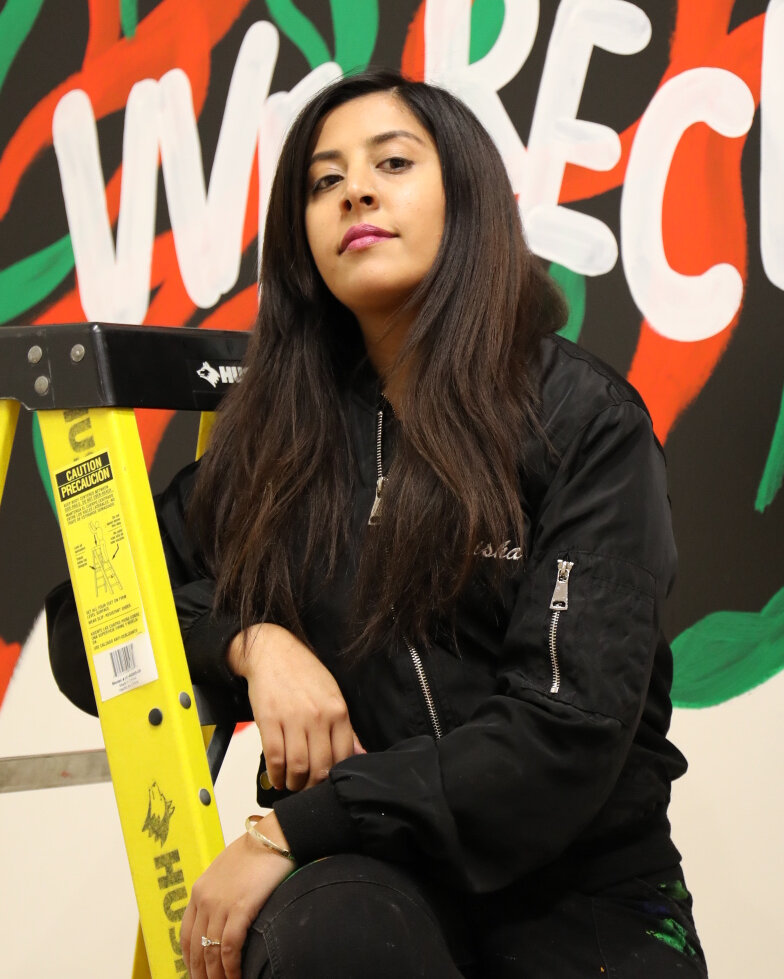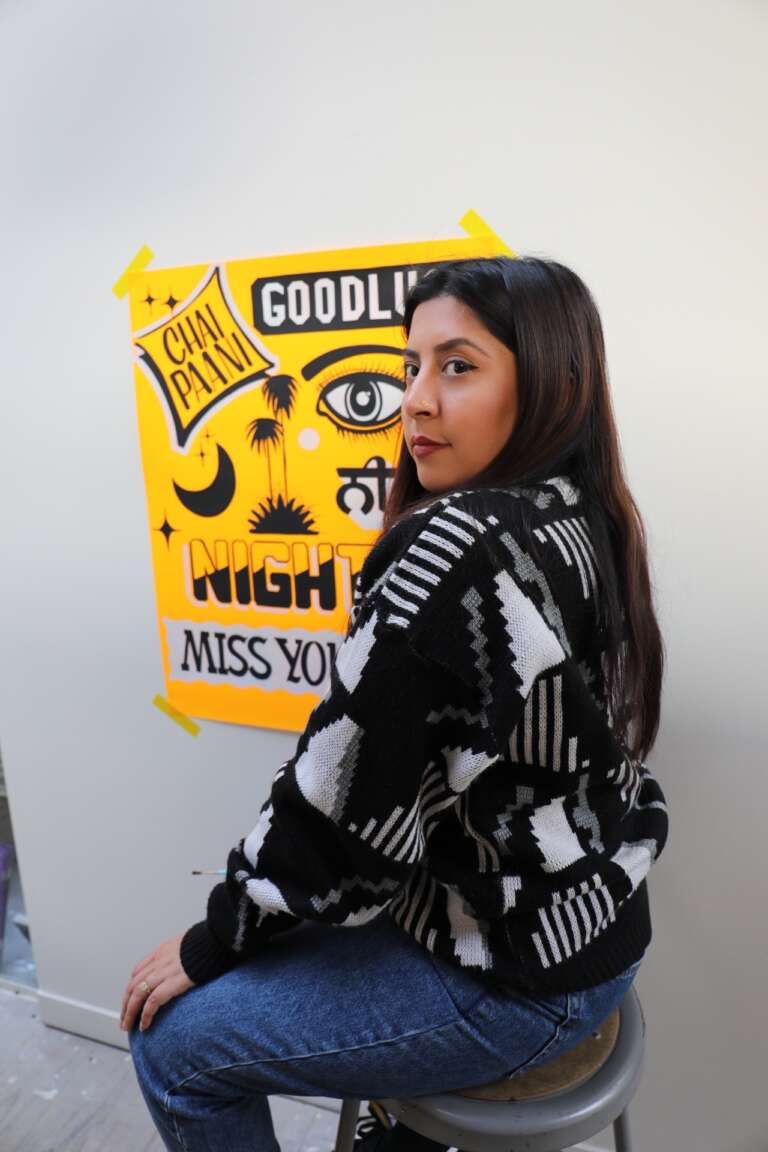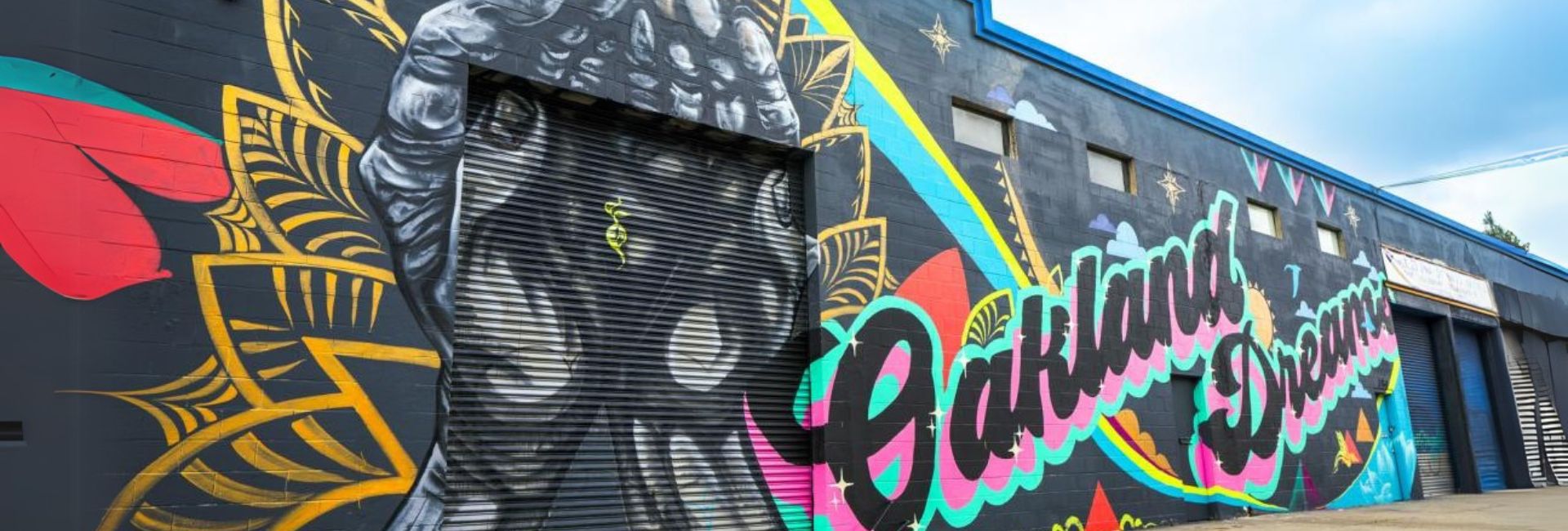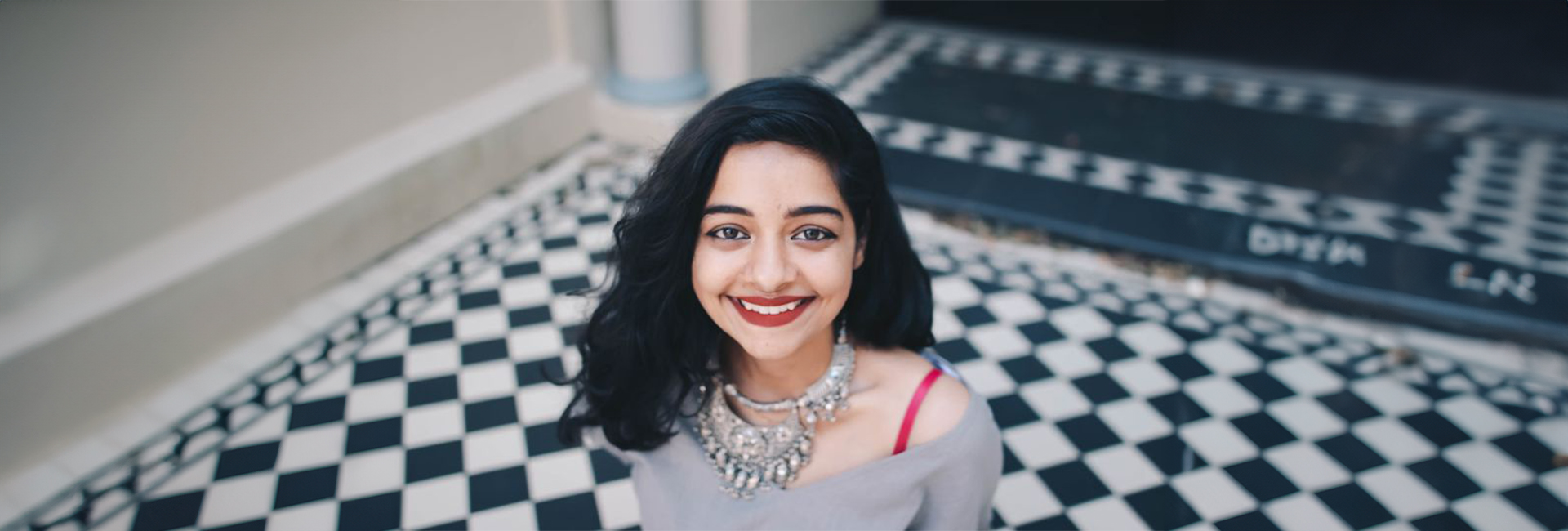(February 14, 2025) A spray can hisses as Nisha Kaur Sethi moves confidently, adding bold strokes of neon green to a London wall. With her bandana covering her face, she transforms a space into a statement. The scent of aerosol fills the air as she steps back to admire her work. For Nisha, graffiti is more than art—it’s a way to reclaim identity, resist erasure, and celebrate heritage. “There is something really special about street art on walls… we’re constantly bombarded by visual media with advertisements and messages, why not create something that people will connect to?,” the Global Indian says.
This belief drives Kalakari Crew, the streetwear brand and artist collective she founded in 2008. Built by next-generation Punjabi immigrants, Kalakari Crew blends hip-hop culture with the vibrant aesthetics of South Asia. “Kalakari is about reclaiming our identity in a society that is constantly appropriating culture. We want people to feel empowered by wearing and representing Kalakari; knowing that we are in touch with our identity and ancestors and that we will not be erased”, the crew states.

Nisha Sethi
Blending Cultures: From Punjab to California
Growing up in Berkeley, California, Nisha Sethi was drawn to graffiti culture. At the same time, her Punjabi heritage played a key role in shaping her artistic vision. Frequent childhood visits to India introduced her to hand-painted film posters, their bold colors and expressive typography leaving a lasting mark.
At home, she navigated the balance between tradition and modernity—rooted in family values but eager to find her own identity in America. Street art became her bridge, allowing her to merge both worlds. Music played a role too. “Growing up in San Francisco, I’ve always been surrounded by graffiti and visual culture but in terms of music, I started to listen to Lauryn Hill, Snoop Dogg… I love gangsta rap. Then as I got older, I started to study history and got into the old school”.
Through these influences, she saw connections between hip-hop’s rebellious energy and Punjabi history’s spirit of resistance. The struggles of her Sikh ancestors, the warrior spirit of the community, and the vibrant, unapologetic storytelling in Punjabi folk traditions—all of it resonated with her.
Punjabi Identity in the US
Punjabis have been an integral part of the American immigrant story for over a century, establishing communities across the country. From farmers in California’s Central Valley to entrepreneurs and academics in major cities, Punjabi immigrants have worked to preserve their heritage while navigating the challenges of assimilation. Despite facing racial discrimination, language barriers, and cultural adjustments, Punjabi Americans have built gurdwaras, cultural institutions, and businesses that keep their traditions alive.

For the younger generation, however, identity is more complex. Many Punjabi Americans find themselves caught between two worlds—honouring their roots while also shaping new, hybrid identities influenced by Western culture. This duality is evident in art, music, and fashion, where South Asian aesthetics are blended with global influences. Artists like Nisha channel this experience into their work, using creativity as a tool for representation and self-expression.
Discovering Her Artistic Path
Nisha’s artistic journey started not with graffiti, but with mehndi designs, which she practiced on friends and notebooks. As her love for visual storytelling grew, she pursued graphic design at San Francisco State University, refining her skills in typography and composition.
However, her real education happened outside the classroom. “The first time I painted with this really OG graffiti writer, he made me paint circles and squares for about two hours before he let me think related to it. Circles and squares, just so I could get a feel for the strokes and pass the tools. It was just not very intuitive”.
Determined to refine her craft, she sought mentorship under Doc Guthrie, one of the last remaining sign painters in the US. This traditional training influenced her signature style—melding South Asian scripts with bold, modern graffiti.
Kalakari Crew: Art as Identity
What started as a graffiti movement evolved into Kalakari Crew, a platform for artistic and cultural expression. Frustrated by the lack of South Asian representation in streetwear, Nisha and her peers decided to create their own. “We saw a lack of women’s streetwear, so we took Kalakari’s creations and started merging our traditions with hip-hop culture”.
Kalakari Crew celebrates Punjabi language, resilience, and humor, with designs featuring slogans like ‘Chup Kar’ (Be Quiet) and ‘Satrang’ (Seven Colors). More than fashion, it became a statement—a way for young Punjabis to proudly showcase their roots.
View this post on Instagram
Nisha’s activism extends beyond clothing. Nisha’s activism extends beyond clothing. Her hand-painted protest signs have been carried at major demonstrations, including the Women’s March, March for Our Lives, UTLA Teacher’s Strike, and Global Climate Strike. Her art is deeply informed by iconic political movements from the 1960s, serving as both a tribute and a call to action.
She is also a printmaker and clothing designer, translating her artwork into wearable pieces through Kalakari. Each design represents more than just fashion—it’s a cultural statement, a form of resistance, and a reflection of the voices she seeks to uplift.
A Voice for the Next Generation
For many young Punjabi immigrants, identity is a constant negotiation. They juggle ancestral traditions with the pressure to blend into Western society. Nisha Sethi understands this challenge. “You really have to work twice as hard to gain any sort of credibility because a lot of people just dismiss you and don’t think you have any real talent”.
Instead of seeking mainstream approval, she focuses on representation. “I just wanted to create art that was relevant to people like me. We don’t really see art that’s reflective of our culture or our background. And I think that it’s empowering to keep that”.
View this post on Instagram
She embraces the impermanence of graffiti, knowing that its fleeting nature doesn’t reduce its impact. “The nature of graffiti is not really to stay there forever, it’s a really temporary sort of element to the culture”.
Her goal is simple: to create art that speaks to young brown people, reminding them of their history and their place in the world.
Looking Forward
From the streets of Berkeley to exhibitions worldwide, Nisha Kaur Sethi’s art bridges past and present, rebellion and tradition, India and America. Her work in graffiti, typography, and streetwear underscores that art is more than aesthetics—it’s about identity, representation, and resistance.
For every mural she paints, every sign she hand-letters, and every Kalakari piece worn with pride, Nisha ensures that the voices of Punjabi immigrants are not just heard, but seen.
- Follow Nisha K Sethi on LinkedIn
Read a similar story of:
Ram Dongre, reviving Indian Mythology.
Sachin Kumar Tiwary, decoding India’s rock-art heritage.




